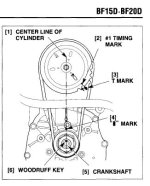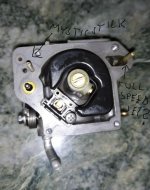jarkko314rto
New member
I do agree with you that the symptoms does not sound like coil break but feeling desperate as well as when I bought that jet set.
This Honda is new for me, I bought it last autumn/winter 2018 (early December, That was freezing day, Hrr) , we did short test drive on lake and symptoms were present already then. Seller told to me that he has not used motor for many years and there might be old gasoline inside. Unfortunately, I don't have more information of the outboard's history.
I have done only the carb cleaning and also checkin the timing belt (I was wondering if belt has installed incorrectly or it has jumped one cog/tooth but I did not found any signs of that. Please find pictures of timing marks from the link below. I really appreciate if you can verify that the markings are enough in line. I assumed that if the timing belt is missed one cog/tooth those marks should clearly be misplaced, which is not the case. Please let me know if I'm wrong. Tension feels for me just great and the belt seems to be ok but it is a subject of change (Just to make sure). Valves are for me something that I haven't touched yet but thank you I will check those too. Metal clamps are really clean and there is no signs of oxidation or rusty.
https://drive.google.com/file/d/1-KZC9_P8mGYfupuQzHzTUk_OK1kBV8un/view?usp=sharing
https://drive.google.com/file/d/1-IQxjUH9jW-JfIKSppghBEEOXmfLpqdO/view?usp=sharing

Upper picture is from my shop manual and it say's also for the valve clearance should be IN 0.15-0.19 mm and EX 0.21-0.25, I will try to check them tomorrow.
Thanks of your support, it's feeling great.
B r Jarkko
This Honda is new for me, I bought it last autumn/winter 2018 (early December, That was freezing day, Hrr) , we did short test drive on lake and symptoms were present already then. Seller told to me that he has not used motor for many years and there might be old gasoline inside. Unfortunately, I don't have more information of the outboard's history.
I have done only the carb cleaning and also checkin the timing belt (I was wondering if belt has installed incorrectly or it has jumped one cog/tooth but I did not found any signs of that. Please find pictures of timing marks from the link below. I really appreciate if you can verify that the markings are enough in line. I assumed that if the timing belt is missed one cog/tooth those marks should clearly be misplaced, which is not the case. Please let me know if I'm wrong. Tension feels for me just great and the belt seems to be ok but it is a subject of change (Just to make sure). Valves are for me something that I haven't touched yet but thank you I will check those too. Metal clamps are really clean and there is no signs of oxidation or rusty.
https://drive.google.com/file/d/1-KZC9_P8mGYfupuQzHzTUk_OK1kBV8un/view?usp=sharing
https://drive.google.com/file/d/1-IQxjUH9jW-JfIKSppghBEEOXmfLpqdO/view?usp=sharing

Upper picture is from my shop manual and it say's also for the valve clearance should be IN 0.15-0.19 mm and EX 0.21-0.25, I will try to check them tomorrow.
Thanks of your support, it's feeling great.
B r Jarkko


